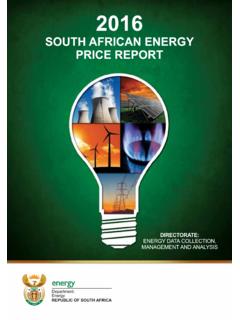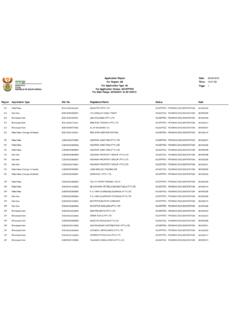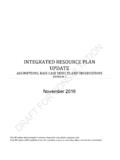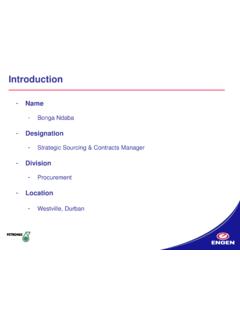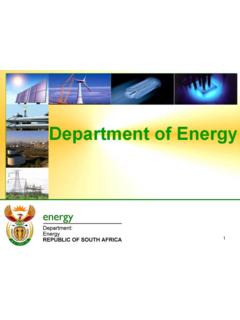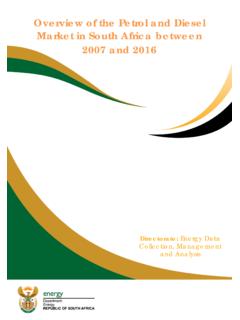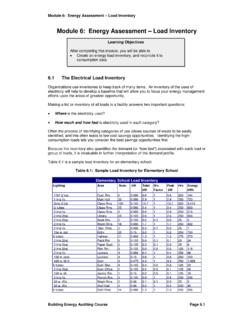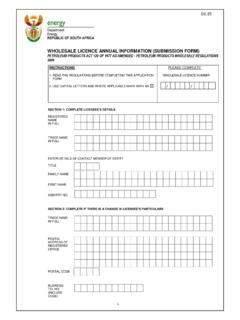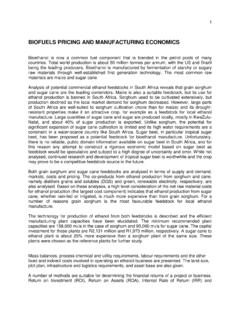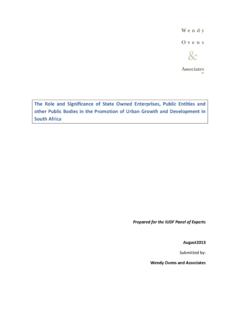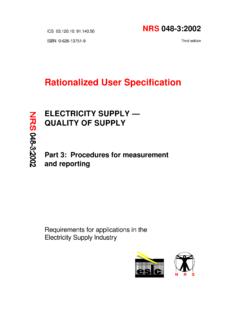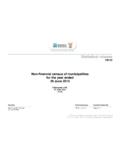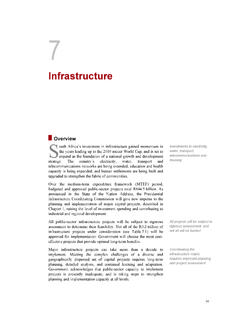Transcription of NATIONAL INVENTORY DISCARD AND DUFF …
1 1 NATIONAL INVENTORY DISCARD AND duff COAL 2001 SUMMARY report EXECUTIVE SUMMARY In 2001 the Energy Branch of the Department of Minerals and Energy commissioned a survey to establish an INVENTORY of the DISCARD and duff coal in South Africa. The objectives of the project were to: up-date the 1985 NATIONAL INVENTORY of South African DISCARD and duff coal; compile an electronic data-base of the INVENTORY ; and to produce a Geographical Information System (GIS) of the INVENTORY . To compile the INVENTORY the appointed consultants prepared a detailed questionnaire which was approved by the NATIONAL DISCARD Coal Steering Committee (NDCSC) before being distributed to the coal mining industry.
2 The response was good, particularly from the mining houses although the level of detail, particularly with respect to quality of the different size fractions was poor. Retrieving the returns and following up on information not provided in the format of the questionnaire proved to be a time-consuming task and delayed the project somewhat. Returns covering 142 DISCARD dumps and slurry ponds were received. All the questionnaires were converted into digital spreadsheets which formed the input of the database and in turn the database formed the platform of the geographical information system.
3 The self-executing GIS was presented to the NATIONAL DISCARD Coal Steering Committee (NDCSC) and the Energy Division in June 2002. To conclude the survey and make the results available to a broader base, it was decided to produce a Summary report of the INVENTORY but maintaining the Private and Confidential 2 confidentiality of the information in the data-base. the Summary report does not attempt to record the details of the data-base and the GIS. Notably, since the last NATIONAL INVENTORY of South African DISCARD and duff Coal was tabled in 1985 it has been estimated, using the monthly returns sent to the Energy Division from the collieries, that a further million tonne of DISCARD and slurry have been produced and dumped.
4 Therefore the register records an enormous 1, million tonne at the time of writing. The 2001 questionnaires indicate that the current annual DISCARD and slurry production is in the order of million tonne. This figure is some million tonne lower than the Energy Divisions register. It has been noted that certain survey questionnaires reported a lower annual tonnage than the same mines monthly returns. Also: nineteen smaller mines did not respond to the 2001 survey; a group of KwaZulu-Natal mines were in liquidation at the time and did not respond; and mines that had scaled down returned lower annual figures.
5 The survey also indicated that cumulative DISCARD and slurry is only half of what is recorded in the register by means of the monthly returns. The survey records 494 million tonne on dumps and in ponds while the register records 1,024 million tonne. This significant difference is partly explained by the following: Questionnaires not returned by some mines; Incomplete returns with respect to tonnage; Mines depositing discards and slurry together with overburden, into old open-cast voids and not recording tonnages for the survey; Historical information of older dumps unknown and not included in the returns; and Ownerless and abandoned DISCARD dumps not recorded in the survey.
6 Private and Confidential 3 The self-executing GIS should be considered as the first attempt to record an INVENTORY of DISCARD and slurry by modern electronic means. It is an extremely valuable tool for accessing the data-base and can be updated as and when required. Notably this exercise was carried out in the strictest confidence and is only accessible through the Energy Division of the Department of Minerals and Energy. Private and Confidential 4 INTRODUCTION Coal continues to remain South Africa s prime energy source with coal fired power generation by ESKOM ( million tonne) and gasification by SASOL ( million tonne) leading local coal consumption.
7 Beneficiated coal is also exported (69 million tonne) while raw sized coal is also consumed for cooking and heating in South Africa s townships. DISCARD coal and slurry are currently being produced at annual rates in excess of 42 million and 11 million tonne respectively. Dumping of raw duff has ceased almost completely and previously dumped duff has been mostly reclaimed where possible. Since the 1985 INVENTORY annual DISCARD production has increased from million tonne (1985) to million tonne (2001). The 2001 survey records only million tonne of DISCARD and slurry deposition.
8 The differential is explained as follows: nineteen smaller mines did not respond to the 2001 survey, accounting for some four million tonne; a group of KwaZulu-Natal mines were in liquidation at the time and did not respond; and mines that had scaled down returned lower annual figures. It is not envisaged that the above-mentioned rates of DISCARD deposition will be maintained because of the following reasons: Closure of a number of collieries including numerous very large producing collieries. The increase of raw coal being sent to utilities using this type of coal, namely ESKOM and SASOL.
9 The production of a middlings product to supply ESKOM and SASOL. The blending of DISCARD , raw coal and slurry for the power generation sector. Reclamation of slurry ponds to supply ESKOM. Private and Confidential 5 The majority of the larger DISCARD dumps are situated in Mpumalanga Province with a large number of smaller defunct dumps in KwaZulu-Natal Province. Utilisation of both DISCARD coal and slurry is being practiced on some mines. DISCARD coal is being re-washed for power station feed, while slurry ponds are being re-treated by froth flotation, producing a saleable product, which is blended with coarser coal fractions and sold as export steam coal or power station feed.
10 With environmental laws becoming stricter, mines are paying greater attention to the methods of DISCARD and slurry disposal. DISCARD coal is now being compacted and the DISCARD dump clad with soil and vegetated. These rehabilitated dumps are potentially reclaimable, the DISCARD being kept under non-oxidising conditions. A substantial amount of DISCARD has either been tipped into opencast voids or mixed with opencast overburden material to fill voids left by the mining operation. This DISCARD is considered un-reclaimable. Numerous collieries are using compacted current DISCARD , to cover or blanket old, smouldering or burnt-out DISCARD dumps to prevent further pollution.
